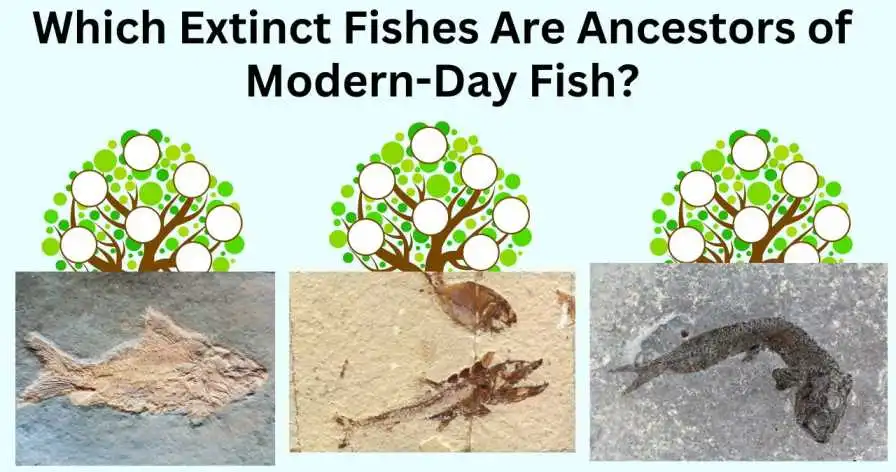The story of fish is a tale of evolution spanning hundreds of millions of years. When asking, “which extinct fishes are ancestors of modern-day fish?” we delve into a fascinating exploration of ancient species that have paved the way for the diverse array of fish we see today. Understanding these ancestral fish helps us trace the evolutionary lineage that leads to modern fish, shedding light on the journey from primitive aquatic organisms to the complex, adaptable species that inhabit our waters now.

Which Extinct Fishes Are Ancestors of Modern-Day Fish? List
Early Progenitors: The Placoderms
One of the earliest gatherings of fish that contributed essentially to the development of current fish were the Placoderms. These heavily clad fish ruled the oceans during the Devonian time frame, around 420 to quite a while back. Placoderms are many times perceived by their hard plates covering the forward portions of their bodies, for certain species displaying a pivot in their defensive layer that considered a strong chomp.
While Placoderms themselves didn’t straightforwardly lead to present day fish, they were among the main jawed vertebrates, a vital transformative step. Their reality prepared for the improvement of further developed fish.
The Chondrichthyans are the Cartilaginous Fish that Ascend:
Sharks, beams, and skates are examples of chondrichthyans, which can be traced back to ancient fish like the Cladoselache. Cladoselache, which had been around for a long time, resembled modern sharks but lacked the distinctive scales found in modern species. These early fish with cartilage played a crucial role in the development of jawed vertebrates. As a result, fish developed a wider range of care methods and environmental preferences.
The ancient Chondrichthyans are thought to be the direct ancestors of the cartilaginous fish that we see today. Their differences, like the development of a cartilaginous skeleton, are a result of their relatives’ experiences in various marine environments.
The Osteichthyans: The Hard Fish Rise
Osteichthyans, or hard fish, is another significant heredity that has had a significant impact on fish evolution. The beam-finned fish (Actinopterygii) and the curve-finned fish (Sarcopterygii) are two important groups within the Osteichthyans.
Fish with curved fins: the Sarcopterygii
Like the ancient Eusthenopteron, curved-finned fish played a crucial role in the evolution of terrestrial vertebrates. The eusthenopteron, which lived a long time ago, had blades that were similar to the appendages of tetrapods—plump, lobed blades. While the majority of the Sarcopterygii were exterminated, their transformative ancestry lives on as coelacanths and lungfish, which are considered living fossils. The varieties found in bend-finned fish laid the reason for the change from maritime to natural life, highlighting their importance in the greater setting of vertebrate progression.

Fish with beam fins: Actinopterygii
Beam-finned fish, which include the vast majority of current fish species, can descend from older fish like the Cheirolepis. Cheirolepis, living around a surprisingly long time back, is one of the earliest realized bar-finned fish. These fish were depicted by their sharp edge radiates, which gave more conspicuous versatility and adaptability in various maritime circumstances.
Transformative Heritage: The Job of Wiped out Fish
The development of present day fish is a complicated story woven through great many long stretches of normal history. Wiped out fish like the Placoderms, Cladoselache, Eusthenopteron, and Cheirolepis are more than simple relics of the past; they are the essential progenitors that formed the course of vertebrate development.
By concentrating on these old fish, researchers can sort out the developmental changes that prompted the variety of life in the present seas, streams, and lakes. The tradition of these wiped-out fish keeps on illuminating our comprehension regarding science, environment, and the complicated snare of life on the planet.
FAQs
What are the ancestors of fish?
The ancestors of fish are thought to be early chordates, such as Pikaia and Haikouichthys, from the Cambrian period. These primitive creatures had basic vertebrate features. Over millions of years, they evolved into more complex forms, leading to jawless fish like lampreys and hagfish, and eventually to jawed fish, which further diversified into the vast array of fish species we see today.
Who are the first ancestors of present-day fish?
The first ancestors of present-day fish are believed to be ancient jawless fish known as ostracoderms, which lived around 500 million years ago during the Cambrian period. These early fish were characterized by their bony armor and lack of jaws, and they are considered the precursors to both jawed fish and other vertebrates.
What fish was once extinct?
The Coelacanth was once thought to be extinct for about 66 million years until it was rediscovered off the coast of South Africa in 1938.
What is the most famous extinct fish?
The most famous extinct fish is probably the Dunkleosteus. This prehistoric fish, which lived about 358–382 million years ago during the late Devonian period, is known for its massive size, armored body, and powerful jaws. It could grow up to 33 feet long and was one of the top predators of its time.
Final Short
The progenitors of present-day fish, presently lengthy wiped out, have made a permanent imprint on the developmental history of life. From the reinforced Placoderms to the spearheading curve finned and beam finned fish, these old species set up for the rich variety of oceanic life we appreciate today. Understanding their commitments improves our insight into transformative science as well as moves a more prominent appreciation for the versatility and flexibility of life on our planet.